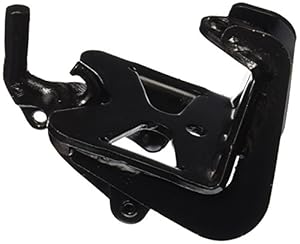It looks like you do have the good bracket and you can see the one with a curved bottom below. The bottom part has a pronounced curve to it. The one I got from Reese is two-piece design with the 2 halves welded together. The bottom and outer sides should be perfectly perpendicular. Looking at the rust around your screw heads and bracket, is that an indication the bracket has been shifting around over time? Our TW is around 950 lbs and the screws loosened shortly after installation and were tightened to the correct Reese torque. That's when I decided to do an upgrade. There is a considerable force exerted onto the brackets when the spring bar notches ride up on the cams and for higher TW and heavier spring bars, keep an eye on the forming screw tightness if screwing directly into the A-frame tubing. Then if you do find them not staying tight, look at upgrading the attachment method.
The radius of the bracket is somewhat larger than the radius of the edge of the A-frame tubing so I made a plate from 3/16" steel to allow the bracket to sit properly against the A-frame. I also included a couple of photos of what I did to attach the brackets. I made a plate with nuts welded to it and welded a 1/2" bolt to the end of a pipe, and cut an access hole in the end of the A-frame tubing to push the plate inside. Then plug-welded the inside plate to the A-frame, ground down the welds and used some touch-up paint over them. I used bolts and not the forming screws and torqued them to 75 ft-lbs and they have held tight since doing this about 2 years ago.
Some info. on the cam arm bracket is
here and has some photos from JBarca. He says not to use the self-tapping screws. Not that it matters but they are correctly called "forming screws" and don't cut a thread, the screw pushes the metal away in the hole to create the thread. The potential problem with the forming screws and higher tongue weights is that the screws are 1/2" x 13 tpi and there's less than 2 threads engaged in the 1/8" wall A-frame tubing. The rivnuts supposedly hold better but I don't have any experience with them. They have a bit of a flange on them which would prevent the side of the bracket from being held tightly and fully against the A-frame which may not be a good thing for higher TW.
You don't have the HD snap-up brackets and need to replace them. The HD snap-up brackets have some additional re-enforcement but looking at internet photos may or may not have the additional mounting holes on the lower outside part. A photo of the HD type is below and you can see the additional re-enforcement which yours don't have. I thought there was always two holes on the lower part are where you can add forming screws if needed but not sure why the holes are square. I recall seeing photos of these brackets literally peeling away from the A-frame from the high vertical forces. According to e-trailer the HD snap-up brackets are needed for TW above 1,000 lbs. When I bought our DC package setup (with 800 lb bars) it came with snap-up brackets with the additional re-enforcement but have the square holes on the lower outside part. Maybe there were different production runs of the HD brackets or made in different countries? The 1st photo of the HD bracket (Reese #58392) below is from carid and the 2nd is from Amazon and one has the holes and one doesn't...
If e-trailer's info. is correct, the standard Reese chains are good for up to 1200 lbs TW so maybe you need to replace them? I would check with Reese on that. Maybe the U-bolts in the bar ends also need replacing in that case?
If you find anything I've posted is useful, happy to help. FWIW, I absolutely love the way the Reese DC WDH performs whether it's on a freeway or on twisty roads in the mountains. Highly recommended!
















